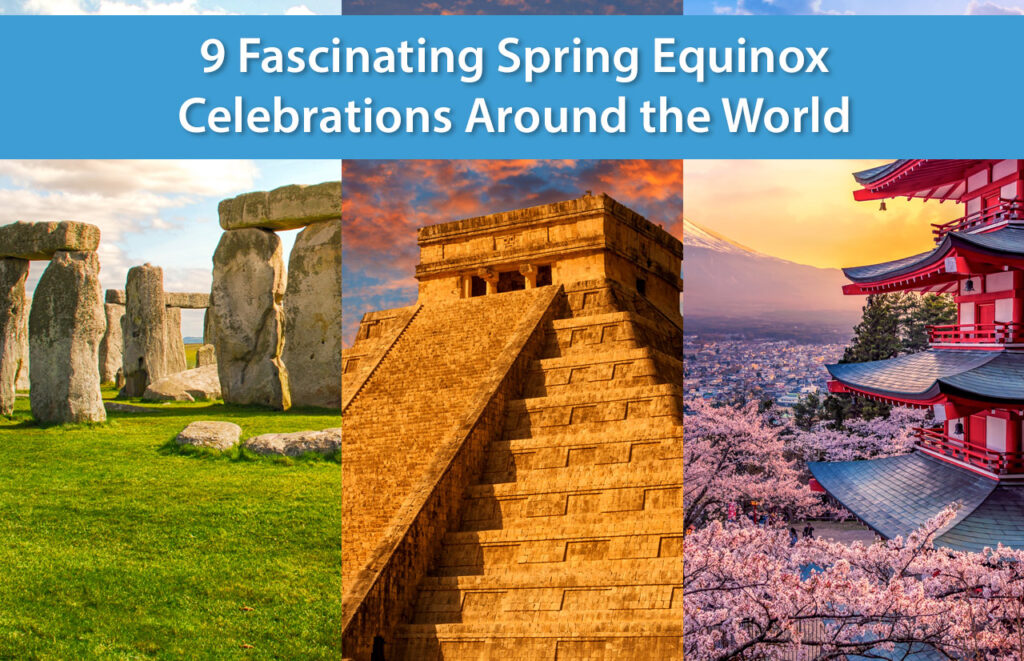“We’re one day closer to spring!” Sounds familiar? It’s a common phrase offered up by those looking to reassure friends and family members that winter will soon be over and warmer days are just around the corner.
As winter winds down, spring anticipation kicks into overdrive for many of us. For some, spring has been on their mind all throughout winter. We long for warm days outside, to hear the birds sing in the morning, to see colorful flowers poke out from the ground and to finally give our heaters a bit of a vacation.
There are so many wonderful things about spring, it only makes sense to celebrate when it finally arrives! Luckily, there are celebrations that take place all around the world to usher in the Spring Equinox which begins on March 19 in 2024. If there is any reason to have a big party, spring is an exceptionally good one, wouldn’t you agree?
In today’s post, we’ll look at some of the most unique and diverse celebrations of this seasonal transition with our 9 Fascinating Spring Equinox Celebrations Around the World:
Table of Contents
1. Holi – India
Want to know the most colorful spring celebration on this list? Look no further than Holi, the Hindu Festival of Colors, typically celebrated in March, and signifying the transition from winter to spring. This vibrant festival is marked by the playful use of colorful powders and waters that are splashed on revelers, symbolizing the diverse hues of life and the purification of body and spirit. While traditions vary throughout the country, the holiday’s roots are steeped in Indian mythology.
Holi reflects the triumph of good over evil and is commonly associated with two Indian legends. In many places, the festival is connected to the legend of Hiranyakashipu, a demon king who ordered his sister to kill his son for worshipping the deity, Vishnu. The son escaped death and vanquished Hiranyakashipu. In other places, the central story is that of Krishna, a Hindu deity, who fell in love with fair-skinned milkmaid Radha, but was ashamed of his dark blue skin, so he playfully colored his face during a game with her and the other milkmaids. This is thought to be the origin of the colored water and powder throwing.
2. Nowruz – Iran
Originating over 3,000 years ago, Nowruz, the Persian New Year, marks the arrival of spring and celebrates renewal and balance in the universe. Nowruz is observed by various communities sharing Persian cultural heritage, including the Balkans, the Caucasus, the Black Sea Basin, the Middle East and others. A centerpiece of the festival is the Haft-Seen table, adorned with seven symbolic items starting with the Persian letter “S,” each representing various aspects of hope and renewal for the coming year.
Some other common traditions include festive preparations with fire and water like ritual dances that sometimes involve jumping over flames. The fire metaphorically purges the bad experiences from the previous year. Family and friends will gather for a traditional spring cleaning, and they will exchange wishes for the coming year, with the eldest giving sweets, coins and presents to the younger children. The customs of the Haft-Seen table and the emphasis on cleanliness contribute to the depth and significance of Nowruz, making it a cherished and meaningful celebration for those who partake in its traditions.
3. Chichen Itza – Mexico
One of the most popular spots to celebrate the Spring Equinox in Mexico is Chichen Itza, a remarkable archaeological site located about 120 miles from the modern-day resort town of Cancun. While historic accounts differ as to when Chichen Itza was built, the centerpiece pyramid of El Castillo serves as a testament to the advanced architectural knowledge of the ancient Mayans. For the Spring Equinox, the sunlight creates a captivating shadow effect on the pyramid, resembling a serpent slithering down the staircase. This phenomenon symbolizes the return of the feathered serpent god Kukulcan to the earth, providing blessings for a full harvest and good health.
Archaeologically, El Castillo highlights the Mayan’s intricate integration of astronomy into their culture and religion. The precision demonstrated in the pyramid’s construction reflects a deep understanding of the solar system, serving both practical and symbolic purposes. The equinox shadow effect, besides marking agricultural times, carries religious significance, reinforcing the connection to the cosmos. As a revered archaeological site, Chichen Itza continues to draw global attention, providing a tangible link to the historical and astronomical achievements of the ancient Mayans.
4. Teotihuacan – Mexico
At its height, Teotihuacan was one of the largest cities of the ancient world, with a population of over 125,000. Now the historic site serves as a gathering spot for those looking to usher in the Spring Equinox. The destination attracts thousands of visitors each year, many dressed in white and red, colors that according to pre-Hispanic tradition help to better absorb the good energy that peaks during the equinox. Many who visit for equinox follow in the footsteps of their ancestors, asking the gods for energy and health in the year.
Festivities for Spring Equinox at Teotihuacan include dancing, burning incense and chanting. At the base of the temples, traditional medicine practitioners will also perform ritualistic cleansings on tourists. The festivities at Teotihuacan not only celebrate the changing seasons but also serve as a cultural and spiritual bridge, allowing communities to honor ancestral roots and reaffirm the enduring connection between humanity and the cosmic forces that shape their traditions.
5. Cherry Blossom Festivals – Japan
Is pink your favorite color? If so, the cherry blossom might just be your favorite tree (or soon to be favorite). While not as prevalent in the United States, except for Washington D.C., the U.S. city most famous for its pink and white-tinged blossoms, the cherry blossom tree is highly prominent in Japan. Its blooming signifies the welcoming of spring, hence the Japanese Cherry Blossom Festival, also known as Sakura.
Since the trees blossom at various times because of weather and climate changes, the festival dates vary by location and year, but they are typically held late March through May. The Japanese festival itself dates back over a thousand years, and prompts people to gather for food, drink, and festivities while the flowers are in bloom. And with over two hundred different varieties of cherry blossom trees in Japan, there are many beautiful sights to soak in. Fun fact: many families will plan a picnic under the blossoming trees and eat themed food that match the pink blossoms including desserts made of anko (made with red bean paste) and Sakura mochi (tinted pink to match the blossoms).
6. Shunbun no Hi – Japan
While the Japanese Cherry Blossom Festival usually takes place over a week or two, the first official day of spring in Japan is known as Shunbun no Hi, and usually occurs on March 20 or 21. It is a national holiday in Japan and most students and workers have the day off.
There are many activities that take place on Shunbun no Hi. Annual graduation ceremonies for universities and high schools are typically held on this day with the blooming cherry blossom trees providing a gorgeous backdrop for celebrations. It is also customary for people to visit ancestral graves to pay their respects and clean the area around their gravestones. With the blossoming of spring, flower viewing is also a popular custom on this day.
7. Spring Equinox in Stonehenge – United Kingdom
One of the world’s most famous places on the planet, Stonehenge is a prehistoric site located on Salisbury Plain, about eight miles north of Salisbury, Wiltshire, England. The incredible monument was supposedly built in several stages between 3000 and 1520 BCE. While ideas about the meaning and significance of the structure have continued to develop in the 21st century, hundreds of people from all over the world gather at Stonehenge to celebrate the Spring Equinox and to figure out its mystery for themselves.
Spring was an especially valuable time of the year for whoever built and tended Stonehenge as it marked new growth after long winter – also the promise of better-fed animals to hunt and a wide variety of food. This significance has continued with many gatherings annually around the site for the equinox. They watch the sun rise above the stones with hopes of growth and energy for the coming spring and summer.
8. Nyepi – Indonesia
While many Spring Equinox celebrations involve people gathering outdoors and sharing in lively activities, there is one observance that’s marked by complete silence: Nyepi. At the beginning of spring each year, the Balinese New Year kicks off in Indonesia. The event itself features 6 days of parades and social gatherings, but Nyepi – known as the Day of Silence – is a sacred Hindu holiday where everyone stays home, shuts out the lights and remains quiet.
In fact, on the day of Nyepi, the entire island of Bali is completely “closed,” including airports, with no incoming or outgoing flights. The roads are off limit too, as everyone is expected to stay indoors for 24 hours, and all restaurants, grocery stores, and other types of shops are shuddered, except for hospitals. The day after Nyepi is the official New Year’s Day, when Balinese Hindus visit families, neighbors and relatives to exchange forgiveness. They also conduct various ceremonies and rituals for the New Year.
9. Ostara – Modern Pagan Celebration
Ostara is a modern Pagan holiday celebrated around the Spring Equinox, typically falling around March 20 or 21 in the Northern Hemisphere. Spring’s Ostara coincides with the time when daylight and darkness are in perfect balance. It’s a celebration of nature’s rebirth, emphasizing the awakening of life after the dormancy of winter, and signifying the triumph of light over darkness.
Commonly thought of as the origin of the Christian Easter, Ostara festivities also involve the painting and decorating of eggs, symbolizing fertility and the potential for new life. Wild hares are associated with the goddess Ostara and represent fertility and abundance. Many Pagans engage in activities that connect them with nature, such as planting seeds, tending to gardens, or taking part in outdoor ceremonies. The focus is on the cyclical nature of life, death, and rebirth, celebrating the Earth’s renewal and the interconnectedness of all living things. Overall, Ostara serves as a time for spiritual reflection, community gatherings, and expressing gratitude for the rejuvenation of the natural world.
The Spring Equinox is marked by diverse and culturally rich celebrations worldwide, reflecting the varied ways in which different societies embrace the arrival of spring and the balance of day and night. Exploring and appreciating these unique traditions not only offers insight into the rich tapestry of human culture but also provides an opportunity for individuals to connect with the universal themes of renewal, growth, and the interconnectedness of all life. There are so many ways to embrace and celebrate the start of spring. Some terrific options to get you into the mood are with spring decor and garden decor from The Bradford Exchange. These artistic treasures can bring that beautiful spring warmth to your space and invite that wonderful feeling of the season inside. It just may be the perfect way to put a bit of spring in your step.

